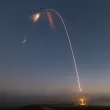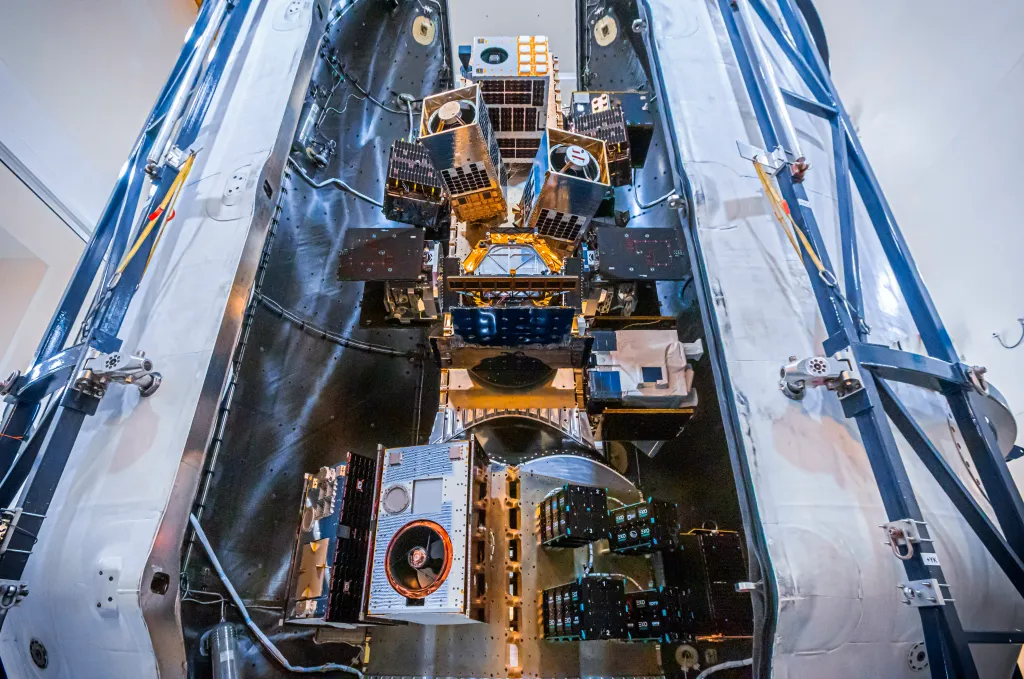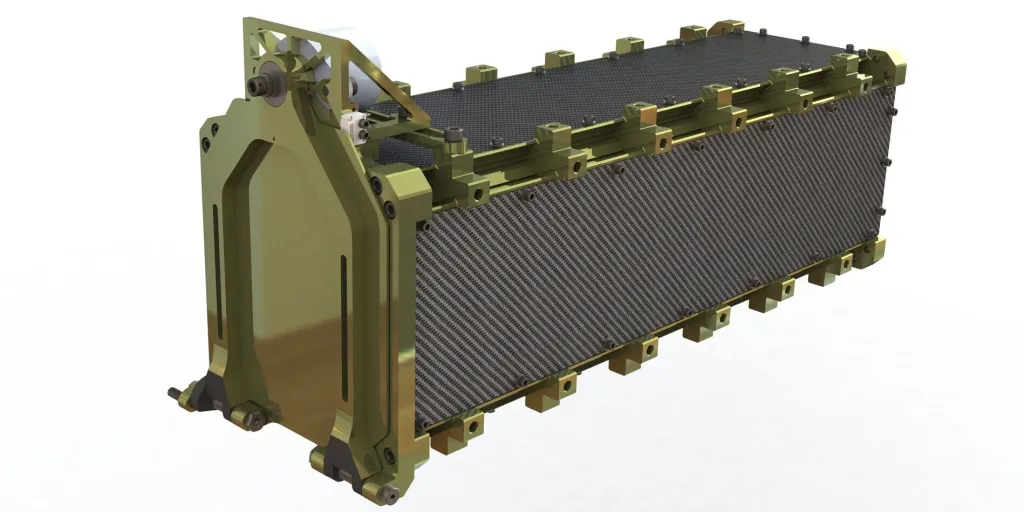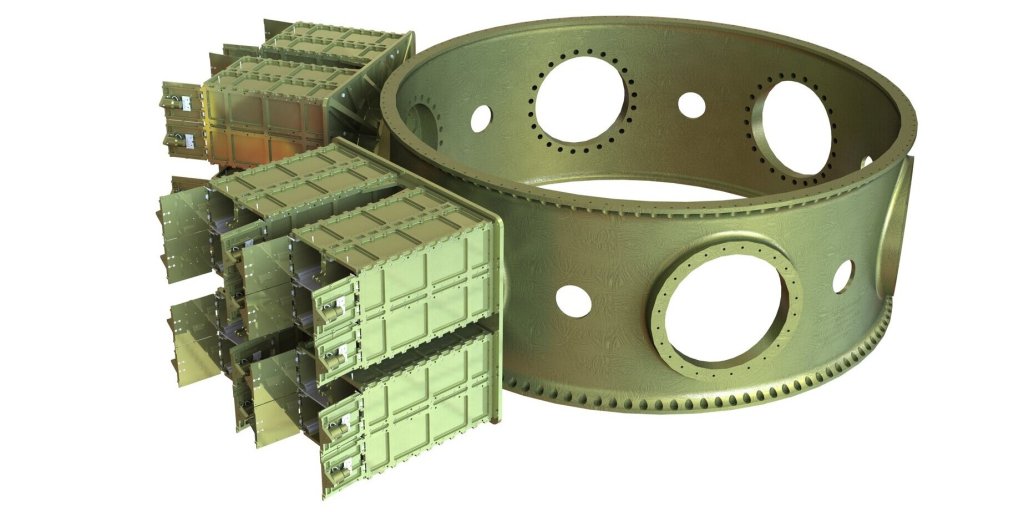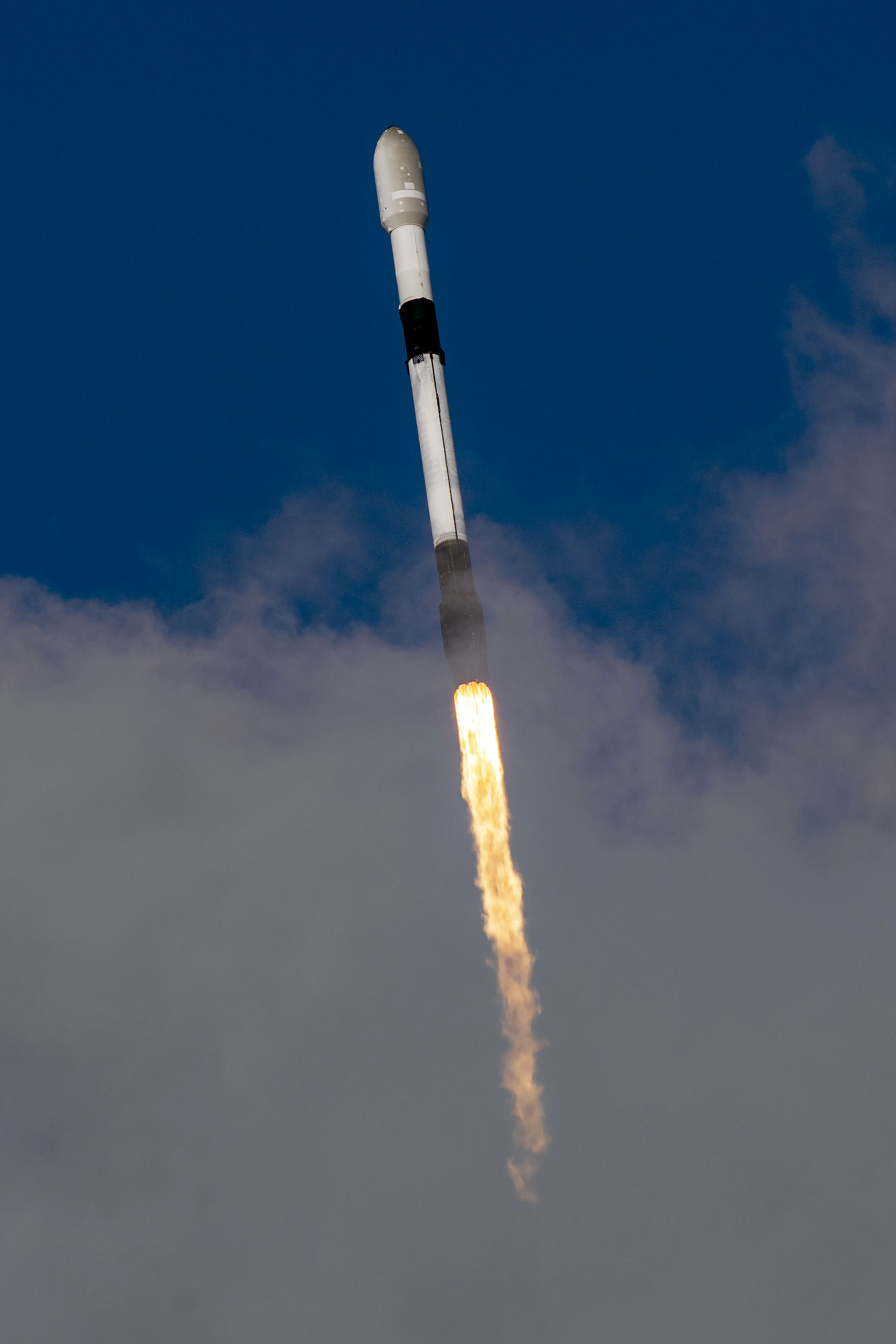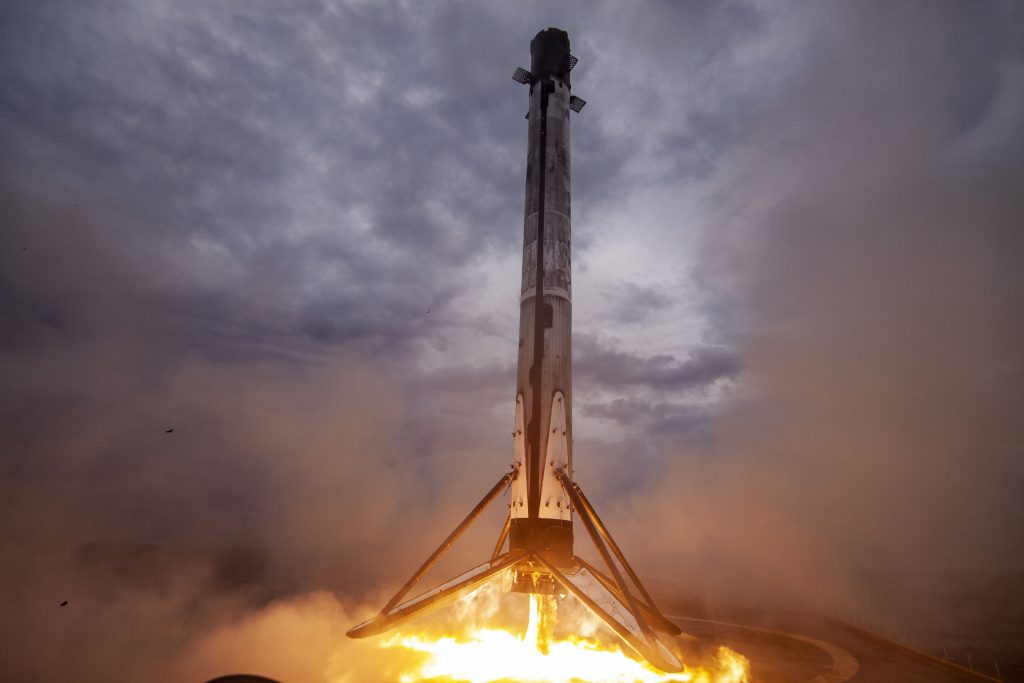Featured Image: John Pisani / Cosmic Perspective
Liftoff Time | March 4, 2024 – 22:05 UTC | 14:05 PST |
|---|---|
Mission Name | Transporter-10, the tenth SpaceX dedicated small satellite rideshare mission |
Launch Provider | SpaceX |
Customer | Numerous |
Rocket | Falcon 9 Block 5, booster B1081-5; 25.65-day turnaround |
Launch Location | Space Launch Complex 4 East (SLC-4E), Vandenberg Space Force Base, California, USA |
Payload mass | Probably around 5,000 kg (~11,100 lb), but TBD |
Where did the spacecraft go? | 1st deployment sequence: a circular ~515 km (~320 mi) Sun-synchronous orbit (SSO) at ~97.45 degrees inclination 2nd deployment sequence: a circular ~590 km (~370 mi) Sun-synchronous orbit (SSO) at ~97.80 degrees inclination |
Did they attempt to recover the first stage? | Yes |
Where did the first stage land? | Landing Zone 4 (LZ-4), at ~400 m (~1,300 ft) from the launch pad |
Did they attempt to recover the fairings? | The fairing halves were recovered from the water ~551 km (~340 mi) downrange by GO Beyond |
Were these fairings new? | Unconfirmed, but SpaceX typically uses flight-proven ones |
This was the: | – 306th Falcon 9 launch – 237th Falcon 9 flight with a flight-proven booster – 251st re-flight of a booster – 20th re-flight of a booster in 2024 – 280th booster landing – 206th consecutive landing (a record) – 16th landing attempt on LZ-4 – 21st launch for SpaceX in 2024 – 69th SpaceX launch from SLC-4E – 43rd orbital launch of 2024 |
Where to re-watch | SpaceX official livestream on X |
What’s All This Mean?
The Falcon 9 Block 5 rocket by SpaceX will launch its tenth dedicated mission under the Smallsat Rideshare Program: Transporter-10. The objective is to send a diverse range of spacecraft into orbit, provided by an array of clients. The rocket will lift off from Space Launch Complex 4 East (SLC-4E) at Vandenberg Space Force Base in California, USA.
After stage separation, the booster will maneuver and initiate a burn to redirect its trajectory, returning to its origin. Then, touchdown of the first stage will take place near the launch pad at Landing Zone 4 (LZ-4). Afterward, the primary objective of the launch vehicle — through its second stage — will be to correctly deploy the satellites and other vehicles into two Sun-synchronous orbits (SSO). One is at an altitude of approximately 515 km (~320 mi) with an inclination of 97.45 degrees, and the other one at 590 km (~370 mi), and 97.80 degrees.
How Did It Go?
The Falcon 9 rocket took off on time beginning the Transporter-10 mission. The launch vehicle achieved all milestones for this flight, including first stage separation and its return to land on Landing Zone 4. All the while, the second stage continued its journey, jettisoning the fairing, and igniting its engine twice before commencing the deployment sequences. Between the two, another two burns took place aimed at changing the orbit. After this maneuver, the payload deployment saw its completion, marking the primary success of the launch mission. In the following days, confirmation of the many payloads’ health should be released. Further deployments from space tugs should also occur, implying additional need of confirmations. Considering the many small spacecraft flying on this rideshare flight, it is not uncommon for this phase to take longer.
What Is Transporter-10?
To meet the demands of the New Space market, SpaceX developed the Smallsat Rideshare Program — more on it below — Transporter-10 being a part of it. This mission consists of a flight to a SSO, where many satellites and orbital transfer vehicles (OTVs, also called space tugs) are to be deployed. Additionally, hosted payloads with a purpose of their own will be present, and dispensers from different providers.
Transporter missions’ manifest is normally eventually made public by SpaceX. Usually, this is published only very close to the date of liftoff, with last-minute payload additions and stand-downs. However, sources report this mission should include OTVs from Space Machines, and Atomos Nuclear and Space (a test tug). Other integration providers listed are Exolaunch, Maverick, and SEOPS. Many entities provided payloads — considering both hosted ones and satellites — and we present them below to the best of our current knowledge.
Transporter Missions
Typically, this kind of shared mission implied waiting for a primary payload — a larger one — to be ready for launch. Then, smallsats would hitch a ride with the launcher booked for the bigger spacecraft. Consequently, these additional passengers had to make do with going into an imposed orbit whenever the large satellite was already. As a result, these factors usually impact their on-orbit performance, unavoidable due to the established launch practices. Moreover, the cost of these rides remained mostly prohibitive for small entities like startups or educational institutions.
Contrary to the general belief back then, SpaceX realized that lowering costs, offering more frequent launches, and attempting to loft spacecraft to more convenient orbits, the smallsat segment of the market could prosper.
Thus, in 2019, the firm announced the offering of rideshare flights aboard its Falcon 9 for such customers, addressing their needs. In effect, these flights would come in two different ways: sharing the room inside the fairing on Starlink missions, or through dedicated rideshare missions named “Transporter”. Both options are part of the Smallsat Rideshare Program.
Moreover, leveraging Falcon 9’s mass to orbit capabilities, a rocket supporting a Transporter mission would see its payload volume subdivided. In this way, interested customers could buy a portion of it as needed, for a much more affordable price. Furthermore, these missions would showcase regular schedules, allowing better in-advance planning, regarding launch date and destination orbit. In spite of this, any payload missing launch day could re-book, paying a small additional fee.
SpaceX offers Transporter launches to low-Earth orbit (LEO), polar LEO, and — its most popular ride — to SSO. In fact, mid-inclination launches have only taken place through Starlink flights, while all past Transporter missions have been to SSO. Revisiting the same spot on Earth’s surface always at the same time of the day — offered by this type of orbit — turns it into a preferred destination.
Notably, a satellite of up to 50 kg (~110 lb) could travel to space for prices as low as USD 275,000 thanks to this type of mission.
Transporter Logistics
From the need for a particular product or service to arrive at the desired orbit and operate the spacecraft, in general many parties participate in one of these missions. To avoid getting lost in the logistics behind the scenes of one of them, it can be thought of in a simplified manner as follows:
- Customer and spacecraft manufacturers: those interested in having a payload in space and those who provide the platform, the instruments on board, or both (basically the payload itself).
- Launch/integration service providers: those who broker rideshare flights, offer last-mile trips (via space tugs), care for meeting regulations, provide dispensers or separation systems, and so on.
- Launch provider: SpaceX, which has overall responsibility for the launch and the correct insertion into the intended deployment orbit.
This structure will be reflected in a subsequent section later in this article where payloads are listed and discussed.
Mechanical Interfaces — Plates
Apart from the logistics aspect, the company also designed specific hardware to integrate payloads. These, in fact, need an interface to the launch vehicle, provided through rideshare plates, conceptually similar to ESPA rings. Each of these plates can be arranged in these configurations: square — four plates — or hexagon — six of them. The former allows for more available volume than the latter.
In turn, the volume corresponding to each of those can be subdivided, using a quarter of the plate, half of it, or full use. These portions enable unique payload accommodations — e.g., a CubeSat dispenser — or standard ports in three different diameters, as follows.
It is worth noting that, though previously designed, these plates were first implemented on Transporter-8.
| Volume Subdivision | 8 in (~20.3 cm) | 15 in (~38.1 cm) | 24 in (~61.0 cm) |
|---|---|---|---|
| 1/4 Plate | Yes | – | – |
| 1/2 Plate | Yes | Yes | – |
| Full Plate | – | Yes | Yes |
| Full Plate XL | – | – | Yes |

Cake Topper
Yet another position to integrate payloads in a rideshare is available at the top of the plate stack. This upper mount enables the launching of spacecraft massing from 500 kg to 2,500 kg during a shared flight. If required, two of them can travel in a side-by-side configuration. In any case, because of the different disposition, a whole separate set of requirements need to be observed when flying as a cake topper.
Previous Missions
| Mission | Date & Time | Orbit | Pad |
|---|---|---|---|
| Transporter-1 | 2021-01-24 15:00 UTC | ~528 km x 97.5° | SLC-40 |
| Transporter-2 | 2021-06-30 19:11 UTC | ~538 km x 97.5° | SLC-40 |
| Transporter-3 | 2022-01-13 15:25 UTC | ~528 km x 97.5° | SLC-40 |
| Transporter-4 | 2022-04-01 16:24 UTC | ~644 km x 97.5° ~503 km x 97.5° | SLC-40 |
| Transporter-5 | 2022-05-25 18:35 UTC | ~528 km x 97.5° | SLC-40 |
| Transporter-6 | 2023-01-03 14:56 UTC | ~525 km x 97.5° | SLC-40 |
| Transporter-7 | April 15, 2023 06:48 UTC | ~500 km x 97,4° ~675 km x 98.2° | SLC-4E |
| Transporter-8 | June 12, 2023 21:35 UTC | ~530 km x 97.5° | SLC-4E |
| Transporter-9 | November 11, 2023 18:49 UTC | ~530 km x 97.5° | SLC-4E |
Payloads On Transporter-10
Many separation events will take place from Falcon 9’s second stage, including OTVs, MicroSats, and CubeSats. Moreover, there will certainly be additional payloads separating the later from space tugs. There is also one official mention of a hosted payload. Our list of the payloads SpaceX is sending to space on this Transporter mission, showing type and quantity, is as follows.
| OTVs: 2 | Deployers: >20 | Satellites: 52 | Hosted: 1 |
Here is a more comprehensive description of Transporter-10’s manifest, to the best of our knowledge so far:
Exolaunch
The Germany-based company offers a series of services, from payload integration, to deployment, and mission management. In order to provide them, Exolaunch developed products such as separation hardware, CubeSat deployers, payload port adapters, deployment sequencers, and it is projecting an OTV named Reliant. Notably, the firm has all previous Transporter missions under its extensive flight expertise.
Deployment Systems
In order to better fit customers’ needs, Exolaunch may assign one or many of its deployment systems. These include:
- CarboNIX: this is a shock-free separator system capable of handling MicroSats massing in the range of 10 kg to 250 kg. To ensure this, different standard sizes are offered, as well as customization. Six CarboNIX separation systems were used in Transporter-9.
- EXOpod: flying since 2017, these deployers have evolved to host all sorts of CubeSat sizes, from 0.25U all the way up to 16U, allowing, in addition, for some combination. 15 EXOpods Nova were used during this mission.
- EXOport: these multiport adapters enable the use of one port on a rideshare plate for a whole CubeSat cluster. A combination of the previous two systems can be used for satellite deployment. Probably no EXOport is used this time, and SpaceX’s Rideshare Plates are used instead.
Payloads Integrated by Exolaunch
The company is flying for the 13th time with SpaceX, making this one its 26th overall mission. In particular, this time, Exolaunch is integrating at least 26 small satellites for many customers from all over the world.
- AEROS: this is a Portuguese 3U CubeSat for CEiiA.
- Aerospacelab: four MicroSats named Rose, Loulou, Riri, and Fifi.
- BRO-12/13: a pair of 8U CubeSats for the French Unseenlabs.
- ContecSat-1 (Oreum): a 16U CubeSat for Contec, a Korean firm.
- HORACIO: a 16U CubeSat for Satlantis.
- Hubble-1/2: two LEMUR-2 CubeSats with a 16U form factor, through Spire for Hubble Network.
- ICEYE X-36/37/38: three MicroSats for ICEYE.
- IOD-6 Hammer: a 6U CubeSat for UK-head quartered Open Cosmos.
- IRIS-F1: this is a 3U CubeSat by SATORO Space for the Taiwanese National Cheng Kung University.
- LEMUR-2: another two of these CubeSats via Spire, but with unknown form factor.
- MuSat-2: this is a 67 kg (~150 lb) MicroSat by Muon Space.
- ÑuSat-44: a Mark V iteration of Satellogic’s satellites with a mass of about 40 kg (~90 lb).
- OrbAstro-TR2: a CubeSat with 6U form factor for British OrbAstro.
- ONDOSAT-OWL-1/2: a pair of 0.5U CubeSats for Mongolian ONDO Space.
- SONATE-2: this 6U CubeSat belongs to the Julius-Maximilians-Universität in Würzburg, Germany.
- Veery-0E: a 1U CubeSat for Utah-based Care Weather.
- YAM-6: a MicroSat for Loft Orbital with its own payload hub, and featuring a mass of 90 kg (~200 lb).
Maverick Space Systems
Offering mission engineering and launch-related services, this US private company serves both commercial and government clients, who can be domestic or international. It was founded in 2019, and since then it took part in, at least, the first two Transporter missions, the seventh, and the eighth. The firm developed a family of CubeSat dispensers named Mercury, as well as other payload aggregation hardware for rideshare missions.
Payloads Integrated by Maverick
- GHOSt-4/5: two 90 kg (~200 lb) MicroSats for Orbital Sidekick
- Pony Express 2 SV1/2: two 12U CubeSats by Tyvak carrying Lockheed Martin payloads.
- PY-4 1/2/3/4: these are four 1.5U CubeSats for NASA.
- RROCI-2: this is a 12U CubeSat by Orion Space featuring a mass of 18 kg (~40 lb).
SEOPS
Dating back to 2017, the Houston, Texas-based firm provides a wide range of services regarding rideshare launches in general. That is, SEOPS functions as payload integrator, performing operations tasks, and providing hardware to mount customers’ satellites on a launch vehicle. Additionally, the company has developed an OTV named OctoBUS, and a patent-pending inflatable trash disposal system for space.
In the past, SEOPS has already flown Cygnus missions, as well as Transporter missions.
Deployment Systems
- SlingShot: once astronauts attach it to a Cygnus spacecraft after it completed its primary mission, it serves the purpose of deploying CubeSats.
- Equalizer: this is another CubeSat deployer meant for specific form factors, but with some design flexibility to allow customization.
- Rifle: in this case, the company offers this on as the lightest separation mechanism of its kind in the market. It basically is a ring that uses springs to push the satellite away.
- Octo-EQ: it maximizes the use of a 24″ (~60 cm) port, supporting many different CubeSat form factor combinations, having debuted on Transporter-5.
- OctoBUS: it features the capability to haul up to 200 kg (~440 lb) of compartmentalized cargo from LEO to an Earth-escape trajectory, for example.
- VTS: or Vacuum Trash System, is an inflatable “bag” that can be attached to a space habitat, and deployed, in order to store wet trash.
Payloads Integrated By SEOPS
- LACE-A/B (CBAS-LCE): two CubeSats with a 6U form factor, for the US Naval Information Warfare Center and the Missile Defense Agency.
- M3: a 3U CubeSat for Missouri University of Science & Technology.
- PYXIS: a MicroSat massing 145 kg (~320 lb) for the Japanese company Axelspace.
- Sentry/Scout-1: this is a 6U CubeSat for US, Maryland-based Quantum Space.
- Tiger-7/8: two 6U CubeSats for OQ Technology, a company from Luxembourg.
Space Machines
Foreseeing the evidently upcoming growth of in-space operations, the Australia-based company prepares to offer corresponding services. Space machines has designed and manufactured what it designates as an orbital servicing vehicle, i.e., Optimus. The firm expects to provide spacecraft transportation, what an OTV does, but also in-orbit assistance, and even exploration as a service, including deep space destinations. To that end, Space Machines delineates a variety of business models, listing one with paid memberships, or another one on-demand, and also dedicated missions.
Optimus
Not much information about this vehicle has reached the public eye, but, as a first step, Optimus-1 should feature a mass of 270 kg (~600 lb). On its lower side, there appears to be a single main engine, while two fixed solar panels should generate electricity. In a photo prior to integration, a third smaller solar panel is visible, with a word written on its cells: perovskite, an unusual photovoltaic material. This could consequently mean, the orbital vehicle will perform tests producing electrical power through cells using this mineral.
Payloads Deployed By Optimus-1
At the date of publishing, the manifest of the payloads riding atop this tug, remains still undisclosed. In Space Machine’s pictures, it would appear there are at least two CubeSat deployers mounted on this OTV.
Other Payloads
About the following group of satellites, there is still no certainty regarding the entity carrying out their integration.
- Aries: a demonstrator MiniSat with a mass of 200 kg (~440 lb) for Los Angeles-headquartered firm Apex, and hosting multiple payloads.
- Jackal X-1L-001/2: these are two 275 kg (~610 lb) autonomous orbital vehicles by True Anomaly.
- LizzieSat: a MiniSat featuring a mass of about 100 kg (~220 lb) by Sidus Space.
- Quark-LITE: a small orbital transfer vehicle demonstrator massing 118 kg (~260 lb) by Atomos Nuclear and Space.
- Gluon: test satellite attached to Gluon, and featuring a mass of 73 kg (~160 lb) by Atomos Nuclear and Space.
- MethaneSAT: a SmallSat with a 366 kg (~810 lb) mass for MethaneSAT.org, a subsidiary of the Environmental Defense Fund.
- Tower 5/6: these are two 85 kg (~190 lb) MicroSats by Lynk Global.
What Is Falcon 9 Block 5?
The Falcon 9 Block 5 is SpaceX’s partially reusable two-stage medium-lift launch vehicle. It consists of a reusable first stage, an expendable second stage, and, when in payload configuration, a pair of reusable fairing halves.
First Stage
The Falcon 9 first stage contains nine Merlin 1D+ sea-level engines. Each engine uses an open gas generator cycle and runs on RP-1 and liquid oxygen (LOx). Each engine produces 845 kN of thrust at sea level, with a specific impulse (ISP) of 285 seconds, and 934 kN in a vacuum with an ISP of 313 seconds. Due to the powerful nature of the engine, and the large amount of them, the Falcon 9 first stage is able to lose an engine right off the pad, or up to two later in the flight, and be able to successfully place the payload into orbit.
The Merlin engines are ignited by triethylaluminum and triethylborane (TEA-TEB), which instantly burst into flames when mixed in the presence of oxygen. During static fire and launch the TEA-TEB is provided by the ground service equipment. However, as the Falcon 9 first stage is able to propulsively land, three of the Merlin engines (E1, E5, and E9) contain TEA-TEB canisters to relight for the boost back, reentry, and landing burns.
Second Stage
The Falcon 9 second stage is the only expendable part of the Falcon 9. It contains a singular MVacD engine that produces 992 kN of thrust and an ISP of 348 seconds. The second stage is capable of doing several burns, allowing the Falcon 9 to put payloads in several different orbits.
SpaceX is currently flying two different versions of the MVacD engine’s nozzle. The standard nozzle design is used on high-performance missions. The other nozzle is a significantly shorter version of the standard, decreasing both performance and material usage; with this nozzle, the MVacD engine produces 10% less thrust in space. This nozzle is only used on lower-performance missions, as it decreases the amount of material needed by 75%. This means that SpaceX can launch over three times as many missions with the same amount of Niobium as with the longer design.
For missions with many burns and/or long coasts between burns, the second stage is able to be equipped with a mission extension package. When the second stage has this package it has a gray strip, which helps keep the RP-1 warm, an increased number of composite-overwrapped pressure vessels (COPVs) for pressurization control, and additional TEA-TEB.
Falcon 9 Booster
The booster supporting the Transporter-10 mission was B1081-5; as the name implies, the booster had flown four previous times. The booster’s designation changed to B1081-6 upon successful landing.
| B1081’s previous missions | Launch Date (UTC) | Turnaround Time (Days) |
| Crew-7 | August 26, 2023, 07:27 | N/A |
| Dragon CRS-2 SpX-29 | November 10, 2023, 01:28 | 75.75 |
| Starlink Group 6-34 | December 19, 2023, 04:01 | 39.11 |
| PACE | February 8, 2024, 06:33 | 51.11 |
Following stage separation, the Falcon 9 conducted three burns. These burns allowed it to softly touch down the booster on SpaceX’s Landing Zone 4 (LZ-4).
Falcon 9 Fairings
The Falcon 9’s fairing consists of two dissimilar reusable halves. The first half (the half that faces away from the transport erector) is called the active half, and houses the pneumatics for the separation system. The other fairing half is called the passive half. As the name implies, this half plays a purely passive role in the fairing separation process, as it relies on the pneumatics from the active half.
Both fairing halves are equipped with cold gas thrusters and a parafoil which are used to softly touch down the fairing half in the ocean. SpaceX used to attempt to catch the fairing halves, however, at the end of 2020 this program was canceled due to safety risks and a low success rate. On Transporter-10, SpaceX will attempt to recover the fairing halves from the water with their recovery vessel GO Beyond.
In 2021, SpaceX started flying a new version of the Falcon 9 fairing. The new “upgraded” version has vents only at the top of each fairing half, by the gap between the halves, whereas the old version had vents placed spread equidistantly around the base of the fairing. Moving the vents decreases the chance of water getting into the fairing, making the chance of a successful scoop significantly higher.
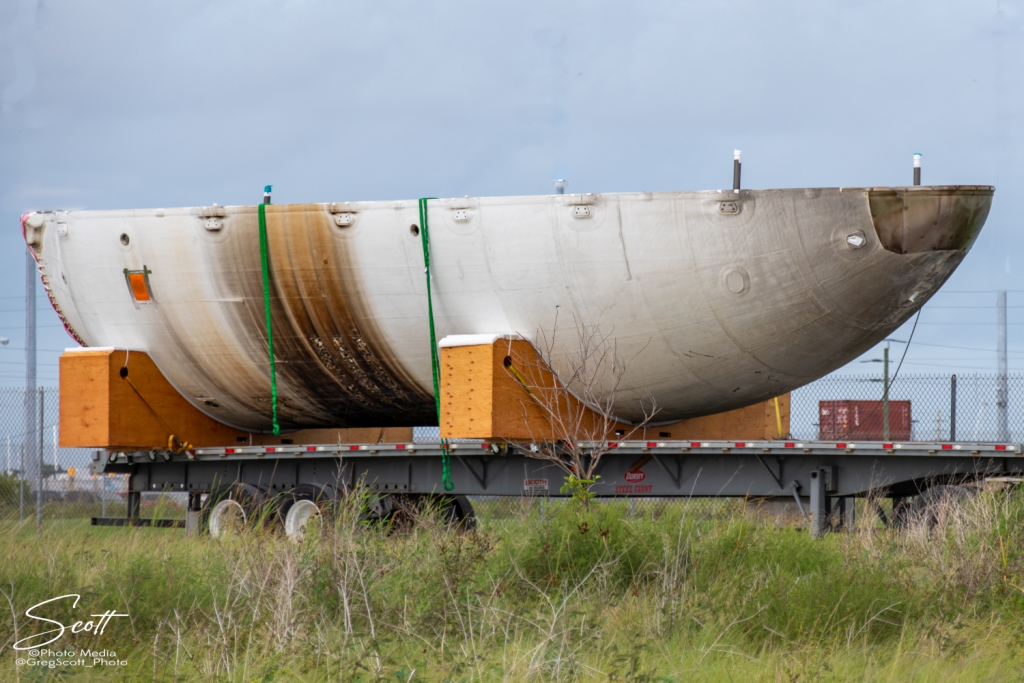

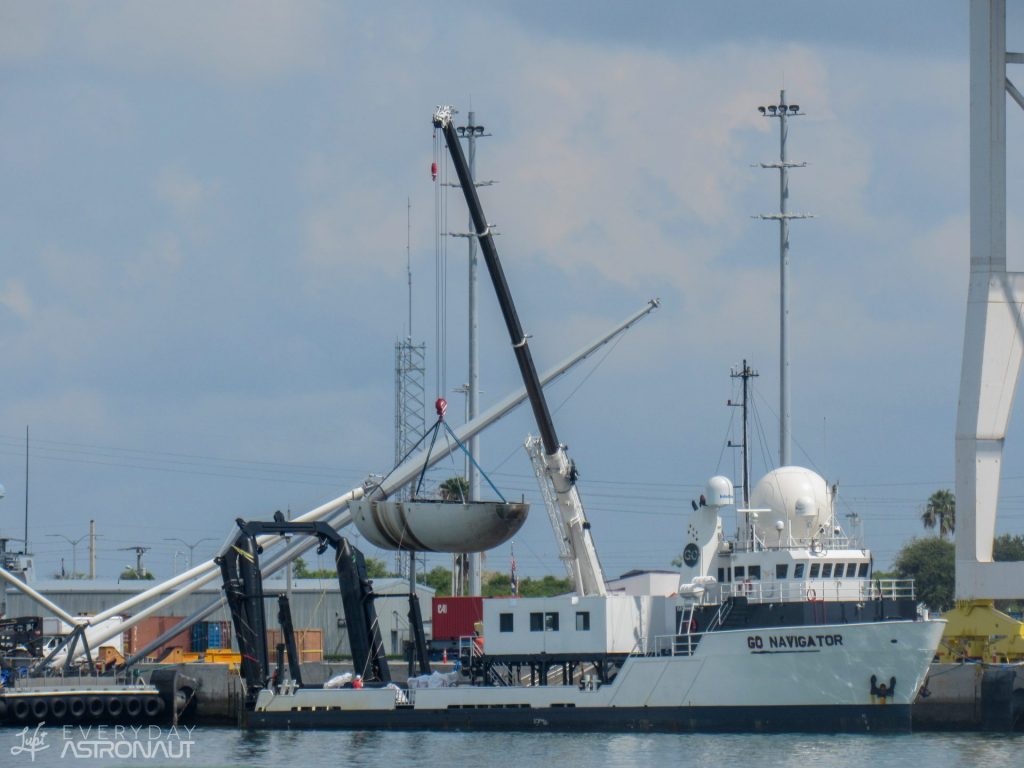
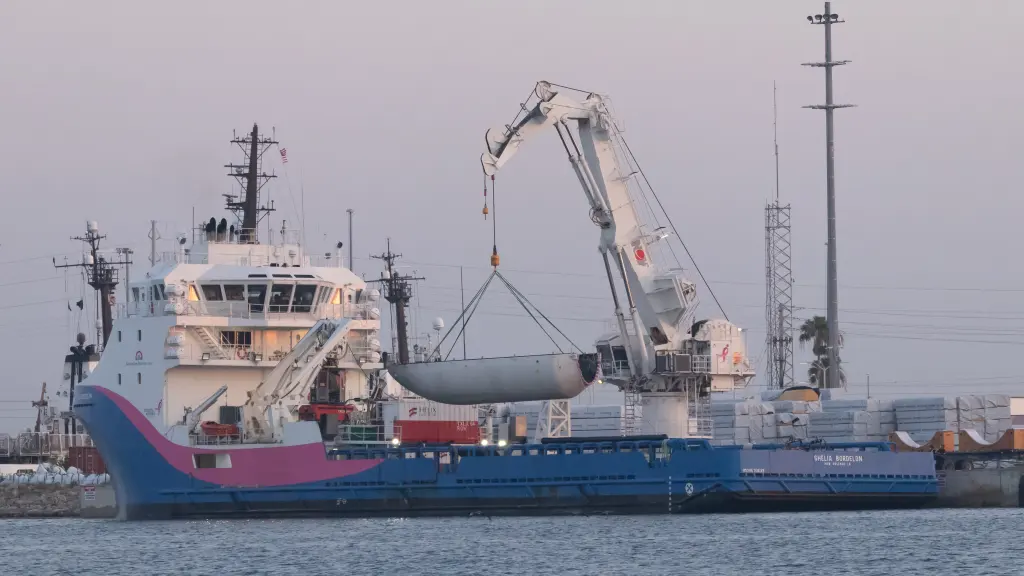
Transporter-10 Countdown
All times are approximate.
| Hr/Min/Sec | Event |
|---|---|
| 00:38:00 | SpaceX Launch Director verifies go for propellant load |
| 00:35:00 | RP-1 (rocket grade kerosene) loading begins |
| 00:35:00 | 1st stage LOX (liquid oxygen) loading begins |
| 00:16:00 | 2nd stage LOX loading begins |
| 00:07:00 | Falcon 9 begins engine chill prior to launch |
| 00:01:00 | Command flight computer to begin final prelaunch checks |
| 00:01:00 | Propellant tank pressurization to flight pressure begins |
| 00:00:45 | SpaceX Launch Director verifies go for launch |
| 00:00:03 | Engine controller commands engine ignition sequence to start |
| 00:00:00 | Falcon 9 liftoff |
Transporter-10’s Launch, And Landing
All times are approximate.
| Hr/Min/Sec | Event |
|---|---|
| 00:01:10 | Max Q (moment of peak mechanical stress on the rocket) |
| 00:02:20 | 1st stage main engine cutoff (MECO) |
| 00:02:23 | 1st and 2nd stages separate |
| 00:02:31 | 2nd stage engine starts (SES-1) |
| 00:02:36 | 1st stage boostback burn begins |
| 00:03:02 | Fairing deployment |
| 00:03:31 | 1st stage boostback burn ends |
| 00:06:08 | 1st stage entry burn begins |
| 00:06:20 | 1st stage entry burn ends |
| 00:07:14 | 1st stage landing burn begins |
| 00:07:32 | 1st stage landing |
| 00:08:17 | 2nd stage engine cutoff (SECO-1) |
| 00:50:12 | 2nd stage engine starts (SES-2) |
| 00:50:16 | 2nd stage engine cutoff (SECO-2) |
Transporter-10’s Deployment I
All times are approximate.
| 00:53:44 | HAMMER deploys, manifested by Exolaunch |
| 00:53:54 | MH-1 deploys, manifested by Exolaunch |
| 00:53:58 | CONTECSAT-1 deploys, manifested by Exolaunch |
| 00:54:04 | PY-4 SV1 and SV2 deploy, manifested by Maverick |
| 00:54:06 | Veery Fledgling “Ectobius” deploys, manifested by Exolaunch |
| 00:54:15 | LEMUR 2 ROCINANTE deploys, manifested by Exolaunch |
| 00:54:35 | LEMUR 2 JOHNNYTRUONG deploys, manifested by Exolaunch |
| 00:54:48 | OrbAstro-TR-2 deploys, manifested by Exolaunch |
| 00:54:59 | SONATE-2 deploys, manifested by Exolaunch |
| 00:55:09 | PY-4 SV3 and SV4 deploy, manifested by Maverick |
| 00:55:11 | ONDOSAT-OWL-1 and ONDOSAT-OWL-2 deploy, manifested by Exolaunch |
| 00:55:24 | LEMUR 2 CHARLIE-ROSE deploys, manifested by Exolaunch |
| 00:55:35 | NCKU-IRIS-F1 deploys, manifested by Exolaunch |
| 00:55:46 | LEMUR 2 FELDHUS deploys, manifested by Exolaunch |
| 00:56:23 | NewSat-44 deploys, manifested by Satellogic |
| 00:57:28 | Lynk Tower 5 deploys, manifested by Lynk Global |
| 00:57:59 | Lynk Tower 6 deploys, manifested by Lynk Global |
| 00:58:19 | OQTech Tiger-7 deploys, manifested by SEOPS |
| 00:58:57 | Missouri S&T M3 deploys, manifested by SEOPS |
| 01:00:08 | OQTech Tiger-8 deploys, manifested by SEOPS |
| 01:00:33 | NWIC Pacific Lace-A deploys, manifested by SEOPS |
| 01:01:07 | NWIC Pacific Lace-B deploys, manifested by SEOPS |
| 01:02:20 | Quantum Space Sentry deploys, manifested by SEOPS |
| 01:03:05 | Axelspace Pyxis deploys, manifested by SEOPS |
| 01:03:38 | Fifi deploys, manifested by Exolaunch |
| 01:04:09 | Rose deploys, manifested by Exolaunch |
| 01:04:36 | Riri deploys, manifested by Exolaunch |
| 01:06:26 | YAM-6 deploys, manifested by Exolaunch |
| 01:09:49 | Loulou deploys, manifested by Exolaunch |
| 01:10:24 | Apex Aries 1 deploys, manifested by Apex Technologies |
| 01:11:00 | Optimus deploys, manifested by Space Machines |
| 01:12:01 | True Anomaly’s Jackal X-1L-002 deploys, manifested by True Anomaly |
| 01:13:11 | True Anomaly’s Jackal X-1L-001 deploys, manifested by True Anomaly |
| 01:13:43 | Quark-lite and Gluon deploy, manifested by Atomos Space |
| 01:14:16 | GHOSt-4 deploys, manifested by Maverick |
| 01:16:36 | GHOSt-5 deploys, manifested by Maverick |
| 01:18:33 | Sidus Space LizzieSat – 1 deploys, manifested by Sidus Space |
Transporter-10’s Orbit Change, And Deployment II
All times are approximate.
| 01:44:26 | 2nd stage engine starts (SES-3) |
| 01:44:27 | 2nd stage engine cutoff (SECO-3) |
| 02:25:51 | 2nd stage engine starts (SES-4) |
| 02:25:51 | 2nd stage engine cutoff (SECO-4) |
| 02:28:39 | BRO-12 deploys, manifested by Exolaunch |
| 02:28:51 | BRO-13 deploys, manifested by Exolaunch |
| 02:29:05 | HORACIO deploys, manifested by Exolaunch |
| 02:29:17 | RROCI-2 deploys, manifested by Maverick |
| 02:29:40 | MuSat-2 deploys, manifested by Exolaunch |
| 02:29:53 | Pony Express-2 SV2 deploys, manifested by Maverick |
| 02:30:33 | Pony Express-2 SV1 deploys, manifested by Maverick |
| 02:31:07 | 1st ICEYE satellite deploys, manifested by Exolaunch |
| 02:31:35 | 3rd ICEYE satellite deploys, manifested by Exolaunch |
| 02:32:03 | 2nd ICEYE satellite deploys, manifested by Exolaunch |
| 02:33:01 | MethaneSAT deploys, manifested by MethaneSat |


